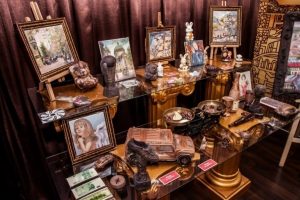
Russia is big and rich in nature. One of the things you can find abundantly in the country is chocolate. There are many chocolate factories, shops, and even museums. You can find one in Chelyabinsk, Saratov, Nikolya-Perm, Cheboksary, and more. The one we will take a look in this article is the one in Astrakhan. It has everything about the juicy facts of Russian chocolate.
Astrakhan is the city of Russia, the administrative center of the Astrakhan region. It is the oldest economic and cultural center of the Lower Volga and the Caspian region, also included in the list of historical cities of Russia.
About the Chocolate Museum in Astrakhan
The Astrakhan Chocolate Museum is located on Admiralteyskaya Street, almost in the very center of Astrakhan. This is not a classic museum, but rather an interactive platform and a creative workshop for chocolate art lovers. The museum is not only fun, bright, informative and unforgettable, but also tasty!
Events you can enjoy at The Museum
Put aside the image of old fashion museums where you can only roam around to explore the museum or getting guided by a tour leader listening to stories behind each exhibit. In the Astrakhan Chocolate Museum, you can attend classes and fun workshops to get hands-on experiences with chocolate.
1. Chocolate Journey Master Class
It is a workshop on the manufacturing of chocolate figures which is the most popular class in the museum and also informative. Here you will have an excursion to the chocolate factory, quizzes, auctions, explanations on legends, interesting facts and even scary stories about this amazing, mysterious, divine product called chocolate.
The workshop is wrapped with the most memorable event of creating chocolate figures with your own hands that you can take home with you afterwards. The most important thing is, during the master class, you will also taste chocolate.
2. Gingerbread Tale Master Class
At this workshop, the children can paint and decorate gingerbread with colored glaze. The masters will also tell various chocolate stories and get the participants to taste six kinds of Belgian chocolate. Here you will find a new, interesting chocolate-gingerbread-honey story!
The class masters will help you understand all the intricacies of the gingerbread craft, plunge into the atmosphere of taste and creativity and leave a sweet impression. Together you will create a unique gingerbread masterpiece and plunge into the world of fragrant ginger dough, sweet colored glaze, miracles, joy and dreams.
3. An Evening of Chocolate Temptation
This is a tasting event for chocolate lovers – a bright unforgettable tasty event of your life that will undoubtedly leave a bright positive mark in your memory. You will spend the evening with friends at a large round table with cups of fragrant tea from a large Russian samovar with honey and bagels.
Together with the museum’s experts in a pleasant atmosphere of chocolate smells, chocolate paintings and sculptures, you will take a magical journey full of tastes and sensations into the magical world of exquisite goodies. You will try chocolate the way it was used thousands of years ago, and learn the taste of chocolate, the way the last Aztec emperor drank it and the French queen loved it.
You will also learn how to easily understand the varieties of chocolate and try several of its tastes, including exotic ones while learning the magical story of chocolate and its legends.
Other Activities Offered by the Museum
If you don’t feel like joining the events mentioned above, a guided tour is always available. The tour includes the history of the origin of chocolate and an exhibition of masterpieces of chocolate creativity. For children, there is a School of Young Chocolatiers with a curriculum that is clearly longer than workshops. Among the figures cast by the museum’s masters, one can find the Kremlin made of chocolate, chocolate portraits of famous personalities and even a chocolate scientist cat sitting under a chocolate oak around the building. During the tour, a small quiz is held on the theme of chocolate, visitors who give the correct answer are awarded with chocolate medals. Sounds pretty interesting, don’t you think?
History of Chocolate in Russia
At the St. Petersburg court, apparently, Catherine II introduced the custom of serving a cup of chocolate in the morning. A great gourmet and lover of chocolate was her first minister, Nikita Panin. For less dignified nobles of the 18th century, the drink, as a rule, was not very accessible. The democratization of hot chocolate occurred after Guten invented cocoa powder followed by the appearance of cheap beet sugar on the market.
In the mid-19th century, chocolate was still brewed in Russia. Turgenev describes in “Spring Waters” a tower of huge porcelain coffee pot filled with fragrant chocolate, surrounded by cups, decanters with syrup, biscuits and rolls, even the flowers.
Hard chocolate conquered Russia only in the last third of the 19th century. The heroes of “Anna Karenina” were treating their children with chocolates. Towards the end of the 19th century, colorfully decorated sets of chocolates started to be produced at the factories of Abrikosov and Einem, which then gained immense popularity. In the Abrikosov’s store on the corner of Nikolskaya Street, goodies like sliced chocolate pineapple cost 2.5 rubles per pound.
In the USSR, chocolate was, for a long time, considered as a delicate and expensive commodity characteristic of a bourgeois lifestyle. It was only in the early 1960s that the Soviet government adopted a new food program, in which special attention was paid to the creation of mass, affordable milk chocolate. The result of the work of Soviet confectioners was the appearance on the shelves of shops in the mid-1960s chocolate brand “Alyonka”, named – according to legend – in honor of the daughter of Valentina Tereshkova. This interesting story is one of many you can hear from the masters at the Chocolate Museum of Astrakhan, Russia.
